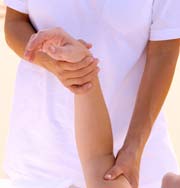What is Acupressure Healing
Acupressure (sometimes spelled accupressure) is a branch of ancient Chinese medicine closely related to acupuncture, that uses pressure rather than needles to restore the balance of chi in the body. In the philosophy of both acupuncture and acupressure, illness and pain is associated with blockages in the natural flow of energy (chi or qi) of the body similar to a dam in a river. These paths of energy are knows as meridians, and the acupoints used in both disciplines allow the practitioner to make adjustmets that help clear blockages all over the body.
Acupressure Video
[youtube 3c7BKU36P9M ]
(Acupressure Video: this contrasts acupressure and reflexology, but still pretty cool)
Acupressure Frequently Asked Questions (FAQ)
Q – Why would someone prefer acupressure to acupuncture?
A – Though there may be as many answers to this as there are patients, there are a few major reasons. Some people may feel uncomfortable about the needles and choose this as a less invasive alternative. Acupressure allows the therapist to feel subtle changes in the energy as they go through the session and make changes in the treatment “on the fly”.
Q – What does acupressure feel like?
A – Most people find it to be extremely relaxing. Varying levels of pressure are used on different points and can be performed on both specific points and general ares of the body. With this in mind, even in the same session, the experience can range from gentle and soothing to a penetrating “good ache” at different points. At no time is acupressure supposed to be painful. If you experience pain, you should alert your practitioner. Be advised that if you suffer from osteoperosis, circulatory disorders, using blood thinners, or have a recent fracture, or if you have any other special condition you must make them known to the therapist to find out what risks are involved.
Q – What should I wear to my appointment?
A – Some acupressure practitioners work through clothing, but others will request you to wear a robe or to be covered in a towel. It is best to wear loose fitting clothes. If you are uneasy about this, you should call in advance and ask your therapist what to expect from their practice.
Q – How much does it usually cost per session?
A – This is a tough question to answer with any accuracy since therapists base their rates on many factors from experience and reputation to the demand for services in their area. Most often the prices range from $40 – $120 per treatment in the US and Canada.
This is a perfect question to ask the acupressure practitioner in your are before you make any commitments as well as finding out about their experience, training, and satisfaction levels of past customers.
Q -What if i’m getting treated also by a regular physician?
A – This is an extremely common situation. Acupressure is frequently used as a complementary treatment to more mainstream medical practices. It is often a good practice to consult your physician prior to beginning alternate therapy programs.
Q – I’ve heard of acupressure for animals. How does that work?
A – The meridians and flow of chi is not specific to humans, but many people report successful treatments for their animals such as horses, dogs, and cats. If you look for them you may find therapists in your area who are trained to specifically work with animals.
Q – Does acupressure work?
A – There are many opinions about chinese medicine in general and many “westerners” historically have many opinions and little experience with it. As far as actual hard statistics, the BBC has a nice little news item reporting that in one study, acupressure was more effective than physical therapy for back pain. There are long lists of illnesses acupressure is said to help heal from pregnancy issues to sexual issues but none are proven conclusively. ( I guess the same could be said of many procedures and medications in western medicine)
Styles of Acupressure
There are various styles of acupressure – some more well known than others. Here are some of the most widely recognized:
- Shiatsu – A japanese form of massage and body work applied with hands, thumbs, knees and elbows that is based on Chinese medicine, yet still distinctively unique. Shiatsu promotes “Diagnosis and Therapy combined” whereas in Chinese medicine, these two functions are kept separate.
- Tuina – Though relatively new to the west, this is one of the four main branches of Traditional Chinese Medicine alongside acupuncture, qigong, and herbal medicine. Studies show it’s use in China at least as far back as 2700 BC making it the forerunner of all forms of massage and body work.
- Qigong Acupressure – This specific branch of acupressure uses principles of Qigong to not only massage the acupoints, but practitioners (of which there are few) inject chi from their hands into the points to help stimulate the balance in the patient’s chi.
- Reflexology – a type of acupressure that focuses on working on the hands and feet in an effort to stimulate wellness all over the body.
Conclusion
If you are a fan or are interested in Traditional Chinese healing techniques, acupressure is a great beginning introduction. Most people find it relaxing and rejuvenating. It is good practice once you are informed of the basics to “interview” a practitioner in advance of any appointments to find out any specific instructions that your practitioner has for you to prepare for an appointment and to see if you are comfortable hiring him or her for your treatment. It is also good practice to be consistent after your treatment with any assignments left for you by your acupressure therapist.
What do you think about acupressure?
Leave your comments below!

Speak Your Mind
You must be logged in to post a comment.